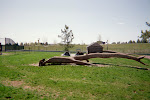Professors are interesting creatures to deal with. If you do not work in academia, please read "The Edge Chronicles" to see what academics can be like with the professors of Sanctaphrax.
My second year working in serials (I work at my alma mater BA '96, MS-ITM '04), one of my former professors sent a non-English speaking student over to my office with a copied page from a journal. All that was on the copied page was part of a first paragraph. At the bottom of the page was part of the title of the serial, but no year or any other information. From what I could gather from the student, his assignment was to find the whole article and copy it.
I took the student to where we had the print serial and tried to convey to him that he now had 12 years of that serial to look through if he wanted to find it. And, of course, this was a serial that started numbering over with each issue. This meant that he would have had to go through 48 issues and look at each page number "45" to try and come across it. Well, the student did not speak enough English for this point to sink in and he kept looking at me blankly.
I took him down to the reference department and explained the problem. Fortunately, they were able to pull enough key words out of the paragraph and find the citation in a database. Whereupon he came back to me and I copied the article for the student to take to the professor.
An amusing p.s. to this story is that the professor had written the article originally. He was glad that we could help provide him with another copy of his article and the correct citation, because he wanted to reference it in another article he was writing!
9.12.2008
Name change and enumeration
OK. Editors are not the most logical people in the world, anyone who works in the serials world knows that.
However, if you change the title, the size and the issn of a serial, shouldn't you also change the numbering or at least start a new volume?
Journal "G" was a title that just "transitioned" to a new title, more pages and a new issn. But, the editors decided to keep going with the volume and numbers from the old title.
So, now I have two records that are going to be fun to deal with. Journal "G" now has volume 53 nos. 1-8 (January-August) 2008. And, now, we have the new title -- Journal "E" -- which has a different layout, a different scope, a different number of pages per issue, different issn and new title -- but has volume 53 nos. 9-12 in 2008.
Luckily enough, we don't bind this title -- which would have been a real nightmare to do! However, we do receive it on microfiche and I'm struggling how to figure out to alert the patron that the last 4 issues of that volume are shelved somewhere entirely different (we shelve microfiche alphabetically and do not keep name changes together).
If the patron should look in the OPAC for the record, there are 780 fields that tell them "continues" and "continued by"....but most of the times patrons are here on weekends and are simply "browsing" through a title on fiche or not sure which card it is on and pull a stack to look through on the viewer.
However, if you change the title, the size and the issn of a serial, shouldn't you also change the numbering or at least start a new volume?
Journal "G" was a title that just "transitioned" to a new title, more pages and a new issn. But, the editors decided to keep going with the volume and numbers from the old title.
So, now I have two records that are going to be fun to deal with. Journal "G" now has volume 53 nos. 1-8 (January-August) 2008. And, now, we have the new title -- Journal "E" -- which has a different layout, a different scope, a different number of pages per issue, different issn and new title -- but has volume 53 nos. 9-12 in 2008.
Luckily enough, we don't bind this title -- which would have been a real nightmare to do! However, we do receive it on microfiche and I'm struggling how to figure out to alert the patron that the last 4 issues of that volume are shelved somewhere entirely different (we shelve microfiche alphabetically and do not keep name changes together).
If the patron should look in the OPAC for the record, there are 780 fields that tell them "continues" and "continued by"....but most of the times patrons are here on weekends and are simply "browsing" through a title on fiche or not sure which card it is on and pull a stack to look through on the viewer.
Labels:
editors,
enumeration,
logic,
name changes,
numbering
9.03.2008
Numbering systems
I know I have blogged about numbering systems before...but... Can someone tell me the point of having the volume, number and whole number plus the date all for enumeration? Or for continuing to use two numbering systems for more than a century (e.g. Old Series Volume and Number, plus New Series Volume and Number)? Or for just abandoning all numbering and changing to month and year only (without any notice, of course)? And is there any sensible reason to change a publishing schedule in the middle of the volume, but with the same numbering but different chronology (thus making predictions and MARC records near to impossible!)? Do the publishers make rational decisions on these things or is it at the whim of the newest editor du jour? "Inquiring minds want to know...." (if you grew up in the 1980's you'll recognize the reference to bad tv commercials for the National Enquirer)
Subscribe to:
Comments (Atom)



